Summary
Birds can see better than humans and are highly susceptible to light, but there is a paucity of scientific data on the visual ability of chickens. Recent research results and practical experience confirm that
lighting programs adapted to specific conditions are a valuable tool in the management of laying hens.
The main points are:
• Artificial light supplied by incandescent lamps operating in a frequency range at 50 Hz is perceived by hens as having a constant flicker. Incandescent or fluorescent light at high frequency, i.e. over 2000 Hz, is preferable for hens.
• Artificial light from conventional light sources, whether filtered or unfiltered, impairs the visual ability of commercial hens, thus limiting the spectrum that is visible to them.
• Hens reared under artificial light and transferred to natural daylight need time to adapt to the altered perception of their surroundings. The use of „true light“ lamps during the growing period, which approximate the natural spectrum, can reduce this effect.
• Stimulation of hens in light-proof houses follows the simple principle of reducing day length until controlled light stimulation is applied and then increasing it. Reducing light hours during the laying period adversely affects egg production.
• Pullets should be reared in light-proof barns or the building should be adapted so that windows can be covered or uncovered according to the lighting program.
• So-called “darkening” of rearing facilities to limit the influence of changing natural day length in the constant period is effective in open house situations and should be used as an option to improve the light stimulation in hot climate countries.
• Open houses for laying hens should have facilities for light-proofing windows, wherever possible. The windows should either be covered and uncovered in step with the lighting program or blacked out completely until the maximum day length is reached.
• Lighting programs for pullets transferred to open barns without the possibility to black- out windows should be adjusted to the hatch date of the flock. To avoid a „light shock“ at transfer when the days are very long, the step-down during rearing should be modified so that the increase at transfer is no more than two or three hours.
• Pullets reared in barns that cannot be light-proofed are influenced by the length of the natural day, especially in the spring and summer months. Premature onset of lay can only be avoided by properly adjusting lighting programs, but light stimulation of such hens is difficult and their production often fails to meet standards.
• Artificial light supplied by incandescent lamps operating in a frequency range at 50 Hz is perceived by hens as having a constant flicker. Incandescent or fluorescent light at high frequency, i.e. over 2000 Hz, is preferable for hens.
• Artificial light from conventional light sources, whether filtered or unfiltered, impairs the visual ability of commercial hens, thus limiting the spectrum that is visible to them.
• Hens reared under artificial light and transferred to natural daylight need time to adapt to the altered perception of their surroundings. The use of „true light“ lamps during the growing period, which approximate the natural spectrum, can reduce this effect.
• Stimulation of hens in light-proof houses follows the simple principle of reducing day length until controlled light stimulation is applied and then increasing it. Reducing light hours during the laying period adversely affects egg production.
• Pullets should be reared in light-proof barns or the building should be adapted so that windows can be covered or uncovered according to the lighting program.
• So-called “darkening” of rearing facilities to limit the influence of changing natural day length in the constant period is effective in open house situations and should be used as an option to improve the light stimulation in hot climate countries.
• Open houses for laying hens should have facilities for light-proofing windows, wherever possible. The windows should either be covered and uncovered in step with the lighting program or blacked out completely until the maximum day length is reached.
• Lighting programs for pullets transferred to open barns without the possibility to black- out windows should be adjusted to the hatch date of the flock. To avoid a „light shock“ at transfer when the days are very long, the step-down during rearing should be modified so that the increase at transfer is no more than two or three hours.
• Pullets reared in barns that cannot be light-proofed are influenced by the length of the natural day, especially in the spring and summer months. Premature onset of lay can only be avoided by properly adjusting lighting programs, but light stimulation of such hens is difficult and their production often fails to meet standards.

Light and the Light Perception of Birds
Light is the visible part of the electromagnetic radiation. It plays an important role for the life of many organisms on earth. Light is perceived by them in different ways.Figure 1: Wavelength Image
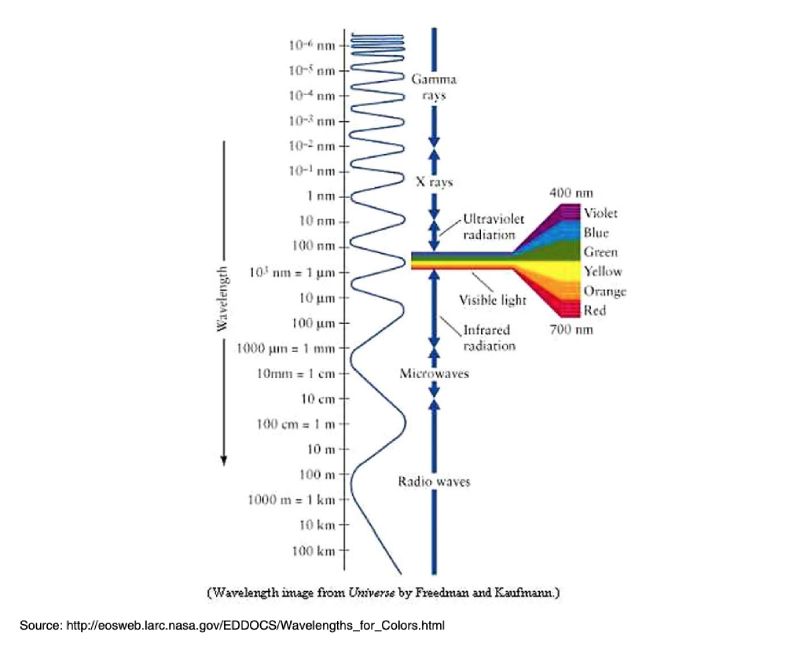
Most vertebrates perceive light via the eye. Light enters the eye and it is projected onto a light-sensitive panel of cells, the retina. So-called cone and rod cells in the retina detect and convert light into neural signals for vision. The visual signals are then transmitted to the brain via the optic nerve and influence the behavior and the sexual activity of the birds. Furthermore the pineal gland and the hypothalamus have some photoreceptors. Their stimulation influences the bird’s life as well. The visual system of birds differs from that of mammals and humans. Birds have perfected the already highly developed visual acuity of their reptilian ancestors. Their visual perception of the environment is different and much sharper than ours. Because of their flying ability and their natural food sources birds are highly visiondependent creatures with anatomical and physiological features which differ from humans. These include in particular the ability to distinguish longer visual sequences of up to 150-250 individual images per second (humans can only see up to 25-30 individual images per second) and their tetrachromatic color vision (trichromatic in man). The latter is made possible by the presence of superior photoreceptors on the avian retina compared with primates, enabling birds to see colors in a spectral range of 360-400 and 600-700 nanometer wavelengths. Birds can see within a UV range that is not visible to humans. These characteristics have to be taken into consideration in the selection of artificial light sources and the design of lighting programs for pullets and laying hens.
Figure 2: Photopigment absorption spectra for a bird (Columba liva) and a primate (homo
sapiens) – Adapted from Bowmaker (1991)

Light Sources and Light Quality
Artificial light sources used in rearing facilities for pullets and laying houses include incandescent lamps, tubular fluorescent lamps and more recently energy-saving lamps. Modern, low-cost LED (light emitting diodes) technology is set to become more widespread in the future, especially if they will be further developed to emit a brighter spectrum of light. High frequency light technology, which generates light approximating the natural spectral range (“true light” technology) is already in use in some poultry operations.Figure : 3. Standard and Full Spectrum Strip Light
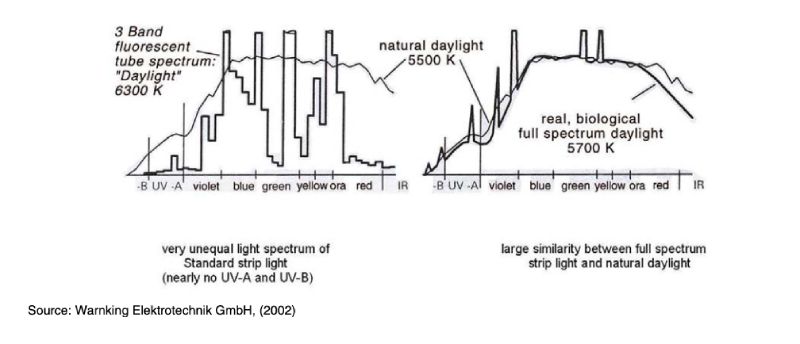
In order to prevent stress-induced behavioral abnormalities, the light intensity in light-proof pullet and layer housing is restricted for commercial reasons to about 5 Lux (rearing) and about 10 to 15 Lux (production) when the hens reach four weeks of age.
The light frequency depends on the light source. Fluorescent tubes and energy-saving lamps operating in the low frequency range (50 Hz alternating current) are considered unsuitable for fowl. Because of their sharp vision, hens perceive the flicker of the light, which can have adverse effects on their behaviour (nervousness, feather pecking and cannibalism). Preference should therefore be given to incandescent lamps whose flicker, despite the 50 Hz frequency of the alternating current, is not perceived because of their slowness, or to fluorescent tubes operating at high frequencies (>2000 Hz). Since incandescent lamps cannot convert electrical power to light as efficiently as other types of lamps, they will soon be banned in most developed countries of the world.
Whereas in the past the choice of light source was determined solely by commercial considerations and by the efficiency of the light source (light intensity), more recently the spectrum and frequency of the light emitted by the lamps have also been taken into account. Systems restricting the light in poultry houses to specific colors (spectral ranges) through the use of filters are currently under consideration. The blue, green and red spectrums are believed to exert different effects on the hens. But even without the color restriction virtually all contemporary artificial light sources cover only a portion of the spectral range that is visible to birds. Natural daylight has a frequency of up to 1015 Hz and if there is sunshine an intensity of more than 100.000 Lux. If hens are kept in barns with windows or roam in covered outdoor enclosures and range areas in natural daylight, there is obviously a vast difference between the quality of the artificial and the natural light, which can be perceived by the hens.
Conventional lamps do not cover the UV range (under 350 nm wavelength), although this range seems to be important for certain stimuli, for example those involved in the search for food and the mating behaviour of birds
To summarize, the artificial light produced in poultry houses by conventional light sources is very different in quality from natural light. Pullets reared in light-proof barns and later exposed to natural daylight perceive their surroundings differently after the transfer and may suffer stress as a result.
Lighting Programs
The lighting program (day length and light intensity) to which a flock of laying hens is subjected during the growing and production phase is a key factor in determining the onset of sexual maturity and egg production. Lighting programs for pullets kept in windowless barns can de designed so as to guarantee optimal growth and efficient preparation for the laying period, largely independent of the season.The “golden rule” to follow in designing lighting programs for pullets is that they should never experience an increase in day length until the planned light stimulation starts and never experience a decrease in day length during the production cycle. Following this principle, the day length is gradually reduced after placement of the day-old chicks in the rearing farm; after the minimum is reached, a phase of constant day length follows; and finally light hours are gradually increased to stimulate the onset of lay.
The so-called “step down” procedure in the early days of the chick’s life can be used to make the pullets more sensitive to light. After reaching 10 to 8 hours per day, the birds are kept on constant day length for some weeks. The length of the day during this constant period determines the stepdown and the following step-up program, it is of minor importance for the pullets’ sensitiveness to light. The more time the birds have during this constant phase, the more they will eat and grow. In situations where farmers have difficulties to achieve the target body-weights, a longer constant day can help to improve pullet quality. Any step-up procedure or increase in day length when birds get to an age of 14 to 15 weeks will stimulate sexual maturation. A quick step-up will induce an earlier onset of egg production, while a slow step-up will delay the onset of lay. The combination of quick step-down and quick step-up lighting is most effective for achieving early onset of lay; slow step-down and slow step-up will delay it. Many scientific trials and practical experience with different strains of layers have confirmed that number of eggs and egg weight can easily be influenced utilising this tool. If a producer wants early egg production, high total egg number and a moderate egg weight, he should use the quick step-down / step-up variant. To get fewer, but larger eggs, a slow step-down / step-up variant should be chosen.
Parent flocks should never be exposed to the quick step-up / step-down program, because small eggs at the beginning of the laying period cannot be used as hatching eggs and therefore undesirable.
Our experience shows that day length should first be increased in the afternoon hours, followed by further increments in the morning hours. This can be done in steps of 30 or 60 minutes as shown in the lighting program for Lohmann Brown layers. Sometimes modern layer hybrids, even if not selected for low feed intake / appetite like the Lohmann strains, have difficulties to consume enough feed shortly before and during the onset of lay. Increasing the day length by two hours initial step-up will not only push them more quickly into lay, but also offers two additional hours to eat. This can be taken into consideration when designing lighting programs for special flocks or housing conditions.
Figure 4: Standard Lighting Program for Lohmann Brown Commercials
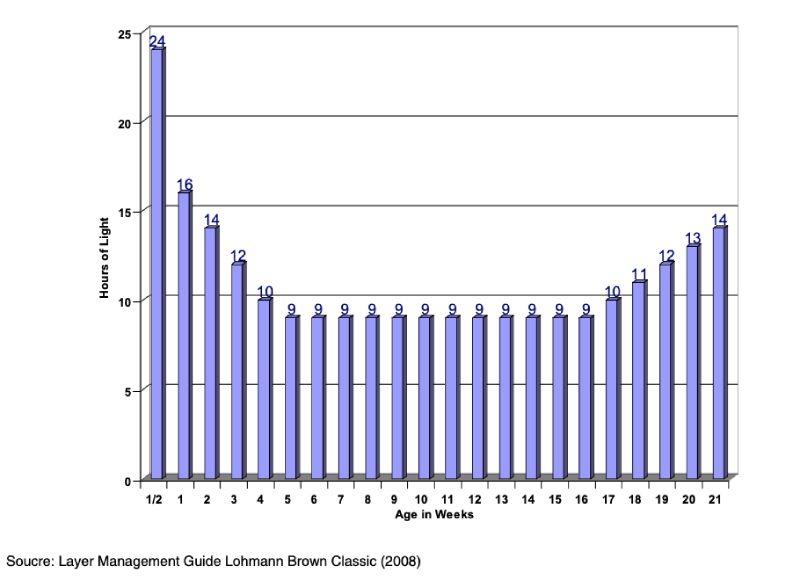
After stimulating flocks properly into lay, there is no need to prolong the day beyond 14 hours day length. Depending on the length of the day during the constant period, even 12 hours are sufficient for top egg production as shown in figures 5 and 6.
In this case, due to a lower activity, the hens have lower nutrient requirements for body maintenance and will consume less feed per day. A reduction of daily feed intake can also be achieved with socalled “block lighting” programs. After birds come into full production, some egg producers take away parts of the light day. This must be done properly to make sure it does not limit the nutrient intake necessary for egg production. As long as this program is asymmetric, the birds are not disturbed in their circadian rhythm and egg laying times are not influenced. This management tool should only be used by experienced farmers in dark house cage production. It has to be used in accordance with poultry welfare regulations in each country.
Figure 5: Adjusted Lighting Program for Lohmann Brown Classic – German Egg Producer
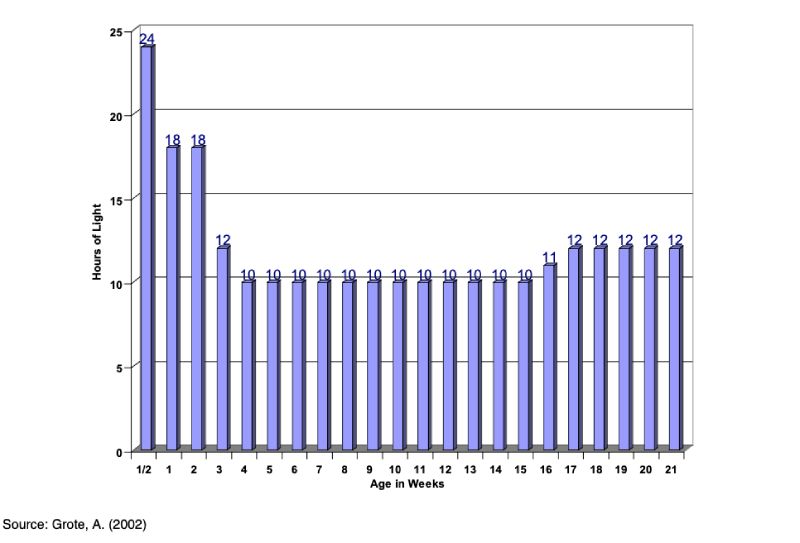
Figure 6: Performance of about 5 Million Lohmann Brown Classic Layers
(Average of different farms in November 2001):
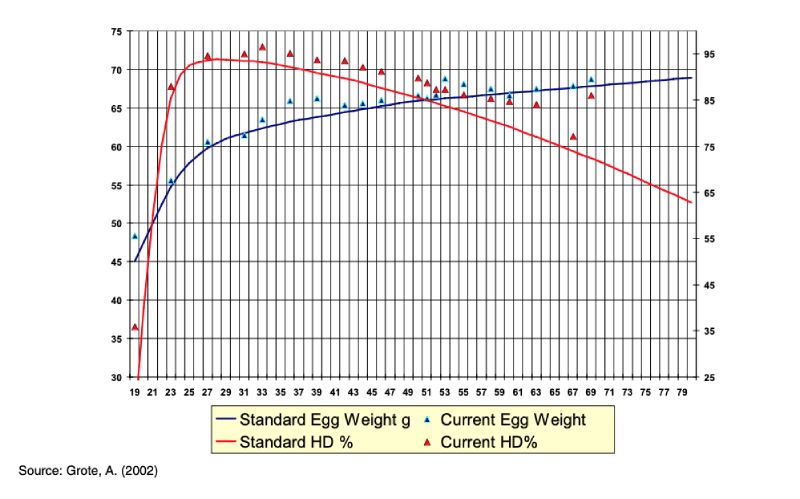
Figure 7: Asymmetric Intermittent Lighting Program (Petersen, 1994)
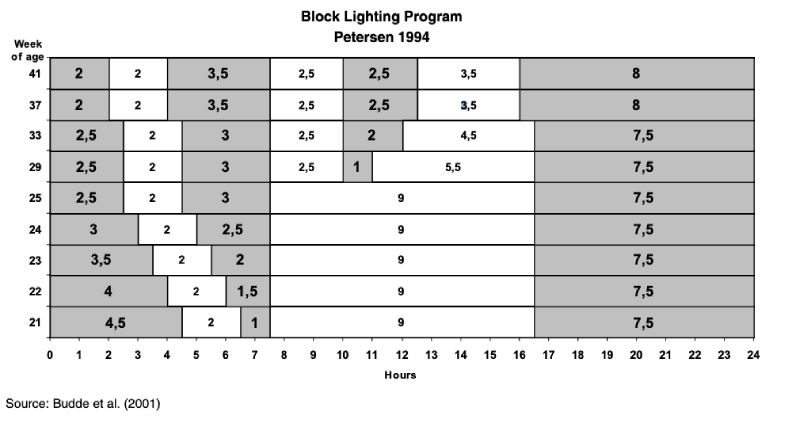
Open Houses
A controlled photo-stimulation of hens should not be abandoned as a management tool in houses with windows. The rearing unit should either be dark-out or the windows should have a facility for blocking out daylight to maintain the lighting program. Shutters can be synchronised with the lighting program and must be seen as very valuable tools.Even under open house conditions, a “darkening program” can improve the performance of flocks significantly. Lohmann Brown layers, for example, reared in an open pullet barn in Colombia (12 hours day light throughout the year) which was darkened to 8 hours day length, came into production two weeks earlier after transfer to an open layer house and produced 20 eggs more than a control group without the “darkening procedure”.
Figure 8: Darkening an Open Pullet Barn (source: Arranguren, 2002)

Figure 9: Comparison of Lohmann Brown flocks reared with and without the darkening
procedure (Armel, 2008)
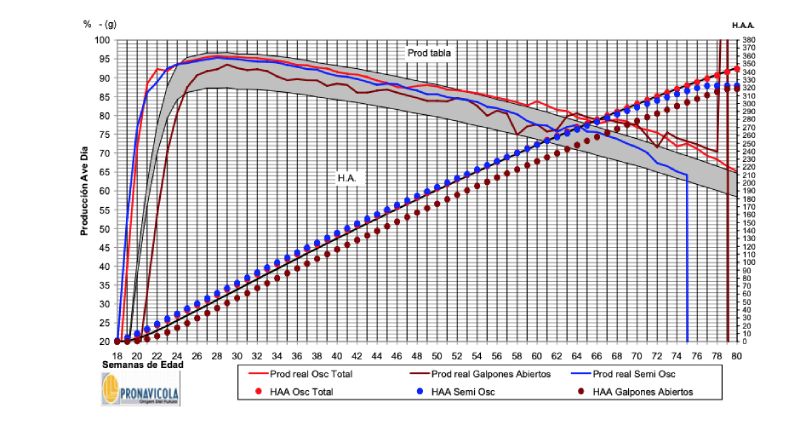
If the hens are placed in open houses or if they have access to a winter-garden or free range, or if windows, ventilation shafts and other openings cannot be light-proofed to keep out natural daylight, this needs to be taken into account when designing the lighting program. In central Europe the natural day length increases in the course of the calendar year to about 17 hours by the end of June and then decreases to about 8 hours by the end of December. If flocks are moved to production facilities whose windows cannot be blacked-out or where natural light can seep through ventilation shafts („extraneous light“), or if winter-gardens or range areas are accessible to the hens at all times, the lighting program must be adjusted to match the natural day length at the time the flock is moved and must be kept constant throughout the rearing phase. It is important to distinguish between pullets from a light-proof growing facility or pullets reared with blacked-out windows (with proper lighting program) and pullets fully exposed to natural daylight throughout the growing period. When pullets unaware of the natural day length during the growing period (light-proof barn or windows that can be blacked-out) are moved to open laying houses it is essential to prevent stress due to excessive light stimulation by an abrupt lengthening of the day. Light hours should not be increased by more than 2-3 hours. This means that day length should not be reduced to 8 or 9 hours during the rearing of such flocks (see Figure 10).
If the natural day is about 14 hours at transfer (17 weeks of age), a reduction to 12 or 11 hours daylight is appropriate. In the case of hens reared in open housing (see Figure 11) premature stimulation of the pullets can only be prevented if the natural day length at the time of the proposed light stimulation of the flock is taken into account when planning the stepwise reduction of light hours in the early growing period. In the example shown, this would be about 14 hours at 17 weeks of age. In open housing the lighting program during the spring and summer months is determined by the increasing natural day length, which peaks at about 17 hours daylight in Germany. When the natural day shortens from July onwards, the 17-hour day length should be kept constant until the end of the laying period.
Figure 10: Adjusted Lighting Program – Berlin / Hatch December / Dark House Rearing and
open House Production
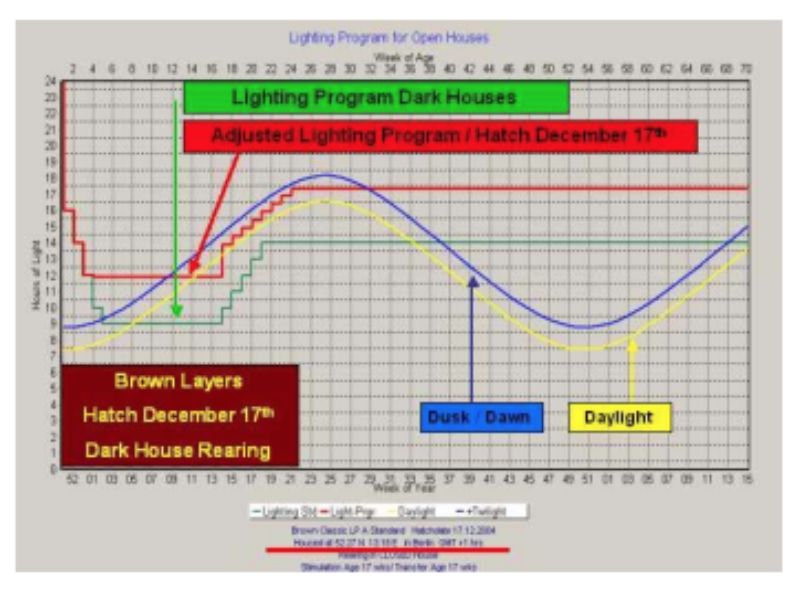
Figure 11: Adjusted Lighting Program – Berlin / Hatch December / Open House Rearing and
open House Productio
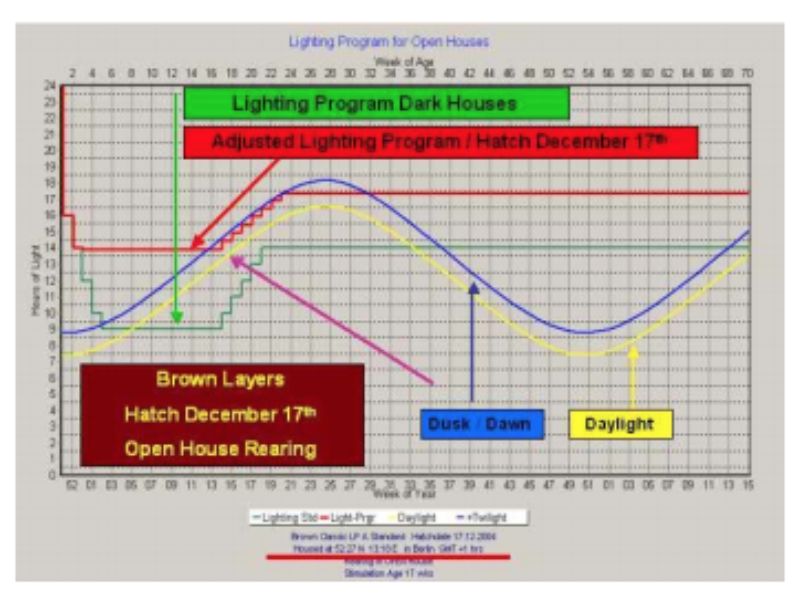
Armel, L. A.Q. (2008): Evaluacion de resultados y concursa al mejor lote Lohmann. Material presented at the Latin American Lohmann School – Medellin 2008.
Arranguren, C.M. (2005): Darkening Program, Presentation at the internal technical service meeting of Lohmann Tierzucht GmbH.
Budde, F.-J., P. Poteracki, I. Simon (2001): Legeleistungsprüfung für Hühner. Schriftenreihe Warenteste Heft 18, Landwirtschaftliches Wochenblatt Westfalen-Lippe.
Grote, A. (2002) : personal communication.
http://eosweb.larc.nasa.gov/EDDOCS/Wavelengths_for_Colors.html
http://www.pigeon.psy.tufts.edu/avc/husband/figure1.htm
Lohmann Tierzucht GmbH (2008): Layer Management Guide Lohmann Brown Classic Warnking Elektrotechnik GmbH (2002): Why good light is important to Poultry
Zusammenfassung
Lichtstimulierung von LegehennenVögel sehen besser als wir Menschen und sind stark visuell abhängige Lebewesen. Wissenschaftliche Erkenntnisse zum Sehvermögen der Hühnervögel sind rar. Einige Ergebnisse jüngerer Forschungsarbeiten und praktische Erfahrungen sollten bei der Haltung von Legehennen jedoch unbedingt berücksichtigt werden:
• Künstliches Licht aus Leuchtstofflampen, die im Frequenzbereich von 50 Hz arbeiten, flackert aus Sicht unserer Hennen ständig. Günstiger für die Tiere sind entweder Glühlampen oder Leuchtstoffröhren, die mit Hochfrequenz, das heißt über 2000 Hz arbeiten.
• Künstliches gefiltertes aber auch schon das nicht gefilterte Licht aus herkömmlichen Lichtquellen schränkt das Sehvermögen unserer Hennen ein. Das von ihnen erkennbare Lichtspektrum wird dadurch begrenzt. Light Stimulation of Commercial Layers Vol. 44 (2), Oct. 2009, Page 48
• Bei künstlichem Licht aufgezogene, in Ställe mit natürlichem Tageslichteinfluss umgestallte Hennen, müssen sich erst an die veränderte Wahrnehmung ihrer Umwelt anpassen. Die Verwendung sogenannter „True Light“ Lampen in der Aufzucht von Junghennen, die fast dem natürlichen Lichtspektrum entsprechen, kann diesen Effekt verringern.
• Die Stimulation der Hennen in Dunkelställen erfolgt nach dem einfachen Prinzip, den Lichttag bis zur gezielten Stimulation der Hennen zu verkürzen, um ihn dann zu verlängern. Eine Verkürzung des Lichttages während der Legeperiode wirkt sich negativ auf die Legerate aus.
• Die Aufzucht von Junghennen sollte in abgedunkelten Ställen erfolgen oder die Ställe sind so einzurichten, dass vorhandene Fenster mit dem Beleuchtungsprogramm synchronisiert geöffnet und verschlossen werden.
• Sogenannte „Verdunkelungsprogramme“ limitieren den Einfluss der sich natürlich verändernden Tageslänge in offenen Häusern und können zur Verbesserung der Licht Stimulierung in tropischen Ländern eingesetzt werden.
• Wenn technisch möglich, sollten „offene“ Ställe für Legehennen auch über Einrichtungen zum Verschließen der Fenster verfügen. Diese können dann entweder ebenfalls synchron zum Beleuchtungsprogramm geöffnet und verschlossen werden oder bis zu Erreichen der maximalen Tageslänge (entsprechend Beleuchtungsprogramm) gänzlich verschlossen bleiben.
• Für Junghennen, die in „offene“ Ställe umgestallt werden, deren Fenster nicht verschlossen werden können, bietet sich die Gestaltung von Beleuchtungsprogramme an, die auf den Schlupfzeitpunkt der Herde abgestimmt sind. Zur Vermeidung eines „Lichtschocks“ bei Umstallung zum Zeitpunkt sehr langer Tage (Frühjahr und Sommer), ist dabei die minimale Tageslichtlänge (Step Down) während der Aufzucht so zu variieren, dass die Hennen bei der Umstallung nur einer Tageslichtverlängerung von zwei, maximal drei Stunden ausgesetzt werden.
• Junghennen, die in Ställen aufgezogen werden, die nicht verdunkelt werden können, werden insbesondere in den Frühjahrs- und Sommermonaten von der Länge des natürlichen Lichttages beeinflusst. Frühreife Junghennen sind nur durch angepasste Beleuchtungsprogramme zu verhindern. Eine wirksame Stimulation solcher Hennen mit Beleuchtungsprogrammen ist jedoch nur begrenzt möglich. Das Leistungsniveau dieser Herden bleibt oft hinter den Erwartungen zurück.







